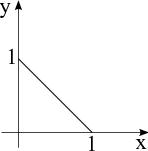Contents
[hide]Example. Two jointly distributed random variables
Two joinly distributed random variables $ \mathbf{X} $ and $ \mathbf{Y} $ have joint pdf
$ f_{\mathbf{XY}}\left(x,y\right)=\begin{cases} \begin{array}{ll} c & ,\textrm{ for }x\geq0,y\geq0,\textrm{ and }x+y\leq1\\ 0 & ,\textrm{ elsewhere.} \end{array}\end{cases} $
(a)
Find the constant $ c $ such that $ f_{\mathbf{XY}}(x,y) $ is a valid pdf.
$ \iint_{\mathbf{R}^{2}}f_{\mathbf{XY}}\left(x,y\right)=c\cdot Area=1 $ where $ Area=\frac{1}{2} $.
$ \therefore c=2 $
(b)
Find the conditional density of $ \mathbf{Y} $ conditioned on $ \mathbf{X}=x $.
$ f_{\mathbf{Y}}\left(y|\left\{ \mathbf{X}=x\right\} \right)=\frac{f_{\mathbf{XY}}\left(x,y\right)}{f_{\mathbf{X}}(x)}. $
$ f_{\mathbf{X}}(x)=\int_{-\infty}^{\infty}f_{\mathbf{XY}}\left(x,y\right)dy=\int_{0}^{1-x}2dy=2\left(1-x\right)\cdot\mathbf{1}_{\left[0,1\right]}(x). $
$ f_{\mathbf{Y}}\left(y|\left\{ \mathbf{X}=x\right\} \right)=\frac{f_{\mathbf{XY}}\left(x,y\right)}{f_{\mathbf{X}}(x)}=\frac{2}{2\left(1-x\right)}=\frac{1}{1-x}\textrm{ where }0\leq y\leq1-x\Longrightarrow\frac{1}{1-x}\cdot\mathbf{1}_{\left[0,1-x\right]}\left(y\right). $
(c)
Find the minimum mean-square error estimator $ \hat{y}_{MMS}\left(x\right) $ of $ \mathbf{Y} $ given that $ \mathbf{X}=x $.
$ \hat{y}_{MMS}\left(x\right)=E\left[\mathbf{Y}|\left\{ \mathbf{X}=x\right\} \right]=\int_{\mathbf{R}}yf_{\mathbf{Y}}\left(y|\left\{ \mathbf{X}=x\right\} \right)dy=\int_{0}^{1-x}\frac{y}{1-x}dy=\frac{y^{2}}{2\left(1-x\right)}\biggl|_{0}^{1-x}=\frac{1-x}{2}. $
(d)
Find a maximum aposteriori probability estimator.
$ \hat{y}_{MAP}\left(x\right)=\arg\max_{y}\left\{ f_{Y}\left(y|\left\{ \mathbf{X}=x\right\} \right)\right\} $
but $ f_{Y}\left(y|\left\{ \mathbf{X}=x\right\} \right)=\frac{1}{1-x}\cdot\mathbf{1}_{\left[0,1-x\right]}\left(y\right) $. Any $ \hat{y}\in\left[0,1-x\right] $ is a MAP estimator. The MAP estimator is NOT unique.
Example. Two jointly distributed independent random variables
Let $ \mathbf{X} $ and $ \mathbf{Y} $ be two jointly distributed, independent random variables. The pdf of $ \mathbf{X} $ is
$ f_{\mathbf{X}}\left(x\right)=xe^{-x^{2}/2}\cdot\mathbf{1}_{\left[0,\infty\right)}\left(x\right), $
and $ \mathbf{Y} $ is a Gaussian random variable with mean 0 and variance 1. Let $ \mathbf{U} $ and $ \mathbf{V} $ be two new random variables defined as $ \mathbf{U}=\sqrt{\mathbf{X}^{2}+\mathbf{Y}^{2}} $ and $ \mathbf{V}=\lambda\mathbf{Y}/\mathbf{X} $ where $ \lambda $ is a positive real number.
(a)
Find the joint pdf of $ \mathbf{U} $ and $ \mathbf{V} $. (Direct pdf method)
$ f_{\mathbf{UV}}\left(u,v\right)=f_{\mathbf{XY}}\left(x\left(u,v\right),y\left(u,v\right)\right)\left|\frac{\partial\left(x,y\right)}{\partial\left(u,v\right)}\right| $
Solving for $ x $ and $ y $ in terms of $ u $ and $ v $, we have $ u^{2}=x^{2}+y^{2} $ and $ v^{2}=\frac{\lambda^{2}y^{2}}{x^{2}}\Longrightarrow y^{2}=\frac{v^{2}x^{2}}{\lambda^{2}} $.
Now, $ u^{2}=x^{2}+y^{2}=x^{2}+\frac{v^{2}x^{2}}{\lambda^{2}}=x^{2}\left(1+v^{2}/\lambda^{2}\right)\Longrightarrow x=\frac{u}{\sqrt{1+v^{2}/\lambda^{2}}}\Longrightarrow x\left(u,v\right)=\frac{u}{\sqrt{1+v^{2}/\lambda^{2}}}. $
Thus, $ y=\frac{vx}{\lambda}=\frac{vu}{\lambda\sqrt{1+v^{2}/\lambda^{2}}}\Longrightarrow y\left(u,v\right)=\frac{vu}{\lambda\sqrt{1+v^{2}/\lambda^{2}}}. $
Computing the Jacobian.
$ \frac{\partial\left(x,y\right)}{\partial\left(u,v\right)}=\left|\begin{array}{ll} \frac{\partial x}{\partial u} & \frac{\partial x}{\partial v}\\ \frac{\partial y}{\partial u} & \frac{\partial y}{\partial v} \end{array}\right|=\left|\begin{array}{cc} \frac{1}{\sqrt{1+v^{2}/\lambda^{2}}} & \frac{-uv}{\lambda^{2}\left(1-v^{2}/\lambda^{2}\right)^{\frac{3}{2}}}\\ \frac{v}{\lambda\sqrt{1+v^{2}/\lambda^{2}}} & \frac{u}{\lambda\sqrt{1+v^{2}/\lambda^{2}}}-\frac{uv^{2}}{\lambda^{3}\left(1+v^{2}/\lambda^{2}\right)^{\frac{3}{2}}} \end{array}\right| $
$ =\frac{1}{\sqrt{1+v^{2}/\lambda^{2}}}\left[\frac{u}{\lambda\sqrt{1+v^{2}/\lambda^{2}}}-\frac{uv^{2}}{\lambda^{3}\left(1+v^{2}/\lambda^{2}\right)^{\frac{3}{2}}}\right]-\frac{-uv^{2}}{\lambda^{3}\left(1-v^{2}/\lambda^{2}\right)^{2}} $
$ =\frac{u}{\lambda\left(1+v^{2}/\lambda^{2}\right)}=\frac{\lambda u}{\lambda^{2}+v^{2}}. $
This is larger than or equal to zero because $ u $ is non-negative.
Because $ \mathbf{X} $ and $ \mathbf{Y} $ are statistically independent
$ f_{\mathbf{XY}}\left(x,y\right)=f_{\mathbf{X}}\left(x\right)f_{\mathbf{Y}}\left(y\right)=xe^{-x^{2}/2}\cdot\mathbf{1}_{\left[0,\infty\right)}\left(x\right)\cdot\frac{1}{\sqrt{2\pi}}e^{-y^{2}/2}=\frac{x}{\sqrt{2\pi}}e^{-\left(x^{2}+y^{2}\right)/2}\cdot\mathbf{1}_{\left[0,\infty\right)}\left(x\right). $
Substituting these quantities, we get
$ f_{\mathbf{UV}}\left(u,v\right)=f_{\mathbf{XY}}\left(x\left(u,v\right),y\left(u,v\right)\right)\left|\frac{\partial\left(x,y\right)}{\partial\left(u,v\right)}\right|=\frac{u}{\sqrt{1+v^{2}/\lambda^{2}}}\cdot\frac{1}{\sqrt{2\pi}}e^{-u^{2}/2}\cdot\frac{\lambda u}{\lambda^{2}+v^{2}}\cdot\mathbf{1}_{\left[0,\infty\right)}\left(u\right) $
$ =\frac{\lambda^{2}}{\sqrt{2\pi}}u^{2}e^{-u^{2}/2}\cdot\mathbf{1}_{\left[0,\infty\right)}\left(u\right)\cdot\frac{1}{\left(\lambda^{2}+v^{2}\right)^{\frac{3}{2}}}. $
(b)
Are $ \mathbf{U} $ and $ \mathbf{V} $ statistically independent? Justify your answer.
$ \mathbf{U} $ and $ \mathbf{V} $ are statistically independent iff $ f_{\mathbf{UV}}\left(u,v\right)=f_{\mathbf{U}}\left(u\right)f_{\mathbf{V}}\left(v\right) $.
Now from part (a), we see that $ f_{\mathbf{UV}}\left(u,v\right)=c_{1}g_{1}\left(u\right)\cdot c_{2}g_{2}\left(v\right) $ where $ g_{1}\left(u\right)=u^{2}e^{-u^{2}/2}\cdot\mathbf{1}_{\left[0,\infty\right)}\left(u\right) $ and $ g_{2}\left(v\right)=\frac{1}{\left(\lambda^{2}+v^{2}\right)^{\frac{3}{2}}} $ with $ c_{1} $ and $ c_{2} $ selected such that $ f_{\mathbf{U}}\left(u\right)=c_{1}g_{1}\left(u\right) $ and $ f_{\mathbf{V}}\left(v\right)=c_{2}g_{2}\left(v\right) $ are both valid pdfs.
$ \therefore $ $ \mathbf{U} $ and $ \mathbf{V} $ are statistically independent.


